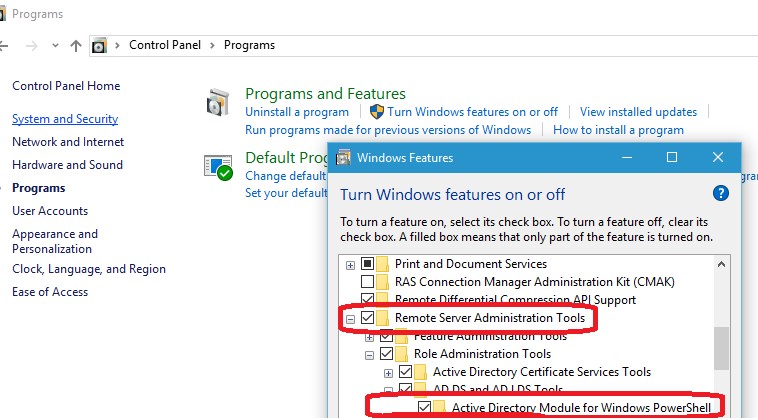

Installation commencingĪfter that, it will delightfully disappear. The installation of the PowerShell module will then begin, and it can take several minutes. Finally selecting the exact feature we need! Microsoft being all helpful and showing you how to proceed – how nice! 😉Ĭlick Start -> Control Panel -> Programs, and then select ‘ Turn Windows features on or off.’ Next, we need to enable the features in Windowsĭrill down to expand Remote Server Administration Tools -> Role Administration Tools -> AD DS and AD LDS Tools and put a checkmark in ‘ Active Directory Module for Windows PowerShell.’ Click OK. Once the installation is complete, you can move on to the next step. Once you have it, go ahead and double-click on it, click Yes to install the update, and click Accept on the license terms. But, thanks to, the past has been retained in some way: You can download the package from this link. Long story short, Microsoft has removed any official downloads for the RSAT package for Windows 7. But, try as you might, you won’t find a download link (It’s just not there…). Now, if you browse to this official Microsoft Documentation link, you’ll see that the RSAT for Windows 7 is discussed. Download and install the Remote Server Administration Tools (RSAT) for Windows 7įirst, you will need to download and install the Remote Server Administration Tools (RSAT) for Windows 7. But, as we are ALL aware, the vast majority of enterprises and SMBs certainly have some Windows 7 machines peeking from behind the curtains. Wait… hasn’t Windows 7 been out of support by Microsoft for around two and a half years (at the time of this writing)? Well, yes… you’re right. Hopefully, this guide will help you be more efficient, especially when it comes to PowerShell scripting and productivity gains. I will assist you in the installation of this rather powerful module on the varying Windows Server and Windows client operating systems. Install Active Directory PowerShell module The best practice recommended by Microsoft is to remotely and securely use the Remote Server Administration Tools (RSAT) arsenal, including the Active Directory module for Windows PowerShell. It is a fundamental security risk and is inefficient, to name two cons.

Microsoft does not recommend the very prevalent and pervasive practice of interactively logging into Active Directory domain controllers (DCs) to work in Active Directory. Exporting the remote AD module to a local module.



 0 kommentar(er)
0 kommentar(er)
